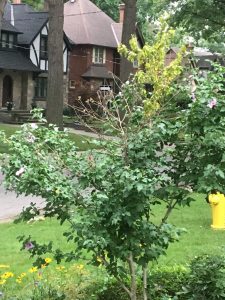
Every year a couple of branches die in my Rose of Sharon. The rest of theshrub look happy and flowers. The sick branch wilts and dies and does not come back. Any answers?
Thank you for contacting the Toronto Master Gardeners with your inquiry.
It is difficult to know what could be the cause of your Rose of Sharon’s dying branches. These shrubs are vigorous, hardy plants with few pest or disease problems with an average life span of 20-30 years. It could be that a few of your branches have succumbed to winter kill. Rose of Sharon prefers full sun, soil that is rich and moist, and is hardy to USDA zone 5 (i.e. Canadian zone 6). Since it is borderline hardy in Toronto, it is best to give it a sheltered location to protect from winter kill.
Have you noticed any insects or holes on your leaves? Pests, which commonly attack this shrub, include aphids, spider mites, Japanese beetles and whiteflies. Have you noticed any round spots on the leaves, a symptom of fungal or bacterial disease, such as the fungal disease cercospora leaf spot. Symptoms of leaf blight first appear on the lower, older leaves as small brown spots with concentric rings that form a “bull’s eye” pattern. As the disease matures, it spreads outward on the leaf surface causing it to turn yellow, wither and die. Other diseases include gray mold, powdery mildew, cankers, and root knot nematode. Symptoms of root knot nematode include the formation of knots or galls on the roots causing the plant to be inefficient in absorbing water and nutrients. Leaves are small and the plants fail to make normal growth. Rose of Sharon Problems.Which does not seem to be your problem since you mention that the rest of your shrub is healthy and robust.
When you notice dying branches, prune away and discard all leaves, branches and stems, making sure the cuts are made with clean, sterile pruning shears or loppers.
Giving it a good 2-3 inch layer of organic mulch around the root zone in the fall will also help. In late spring, after it has leafed out, prune out the winter damaged branches and apply a balanced 10-10-10 fertilizer to give it a head start. A mid-summer application of a low nitrogen 0-10-10 fertilizer will promote root health and flower production. Do not apply fertilizer after August, as this will encourage tender new growth that will not overwinter. Water deeply but not too frequently, and take care not to let in sit in wet soil or the roots will drown. Amend the soil yearly to keep it humus rich and healthy.
A healthy shrub is better able to defend itself against most pests and diseases.

